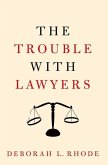Based on an extensive survey of historical, sociological, and legal sources, American Lawyers traces the development of the legal profession during the past century. The most comprehensive work on the subject in over thirty years, this seminal study offers a disturbing portrait of the character, evolution, and future of law and lawyers in the United States. Since their emergence in the last quarter of the nineteenth century, Abel argues, bar associations have consciously shaped and controlled the development of the profession. American Lawyers have deliberately erected entry barriers designed to restrict the number and raise the social status of lawyers, and have intentionally dampened competition. Abel demonstrates how lawyers sought to increase access to justice while simultaneously stimulating demand for legal services, and how they implemented self-regulation to forestall external control. Charting the dramatic transformation of the profession over the last two decades, Abel documents the growing number and importance of lawyers employed outside private practice in business and government.
This detailed portrait of American lawyers traces their efforts to professionalize during the last 100 years by erecting barriers to control the quality and quantity of entrants. Abel describes the rise and fall of restrictive practices that dampened competition among lawyers and with outsiders. He shows how lawyers simultaneously sought to increase access to justice while stimulating demand for services, and their efforts to regulate themselves while forestalling external control. Data on income and status illuminate the success of these efforts. Charting the dramatic transformation of the profession over the last two decades, Abel documents the growing number and importance of lawyers employed outside private practice (in business and government, as judges and teachers) and the displacement of corporate clients they serve. Noting the complexity of matching ever more diverse entrants with more stratified roles, he depicts the mechanism that law schools and employers have created to allocate graduates to jobs and socialize them within their new environments. Abel concludes with critical reflections on possible and desirable futures for the legal profession.
Hinweis: Dieser Artikel kann nur an eine deutsche Lieferadresse ausgeliefert werden.
This detailed portrait of American lawyers traces their efforts to professionalize during the last 100 years by erecting barriers to control the quality and quantity of entrants. Abel describes the rise and fall of restrictive practices that dampened competition among lawyers and with outsiders. He shows how lawyers simultaneously sought to increase access to justice while stimulating demand for services, and their efforts to regulate themselves while forestalling external control. Data on income and status illuminate the success of these efforts. Charting the dramatic transformation of the profession over the last two decades, Abel documents the growing number and importance of lawyers employed outside private practice (in business and government, as judges and teachers) and the displacement of corporate clients they serve. Noting the complexity of matching ever more diverse entrants with more stratified roles, he depicts the mechanism that law schools and employers have created to allocate graduates to jobs and socialize them within their new environments. Abel concludes with critical reflections on possible and desirable futures for the legal profession.
Hinweis: Dieser Artikel kann nur an eine deutsche Lieferadresse ausgeliefert werden.









